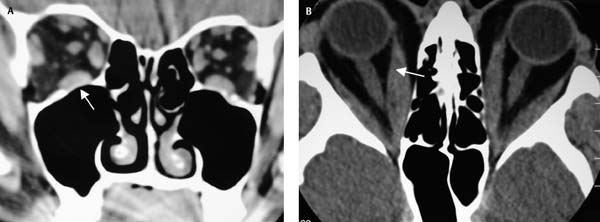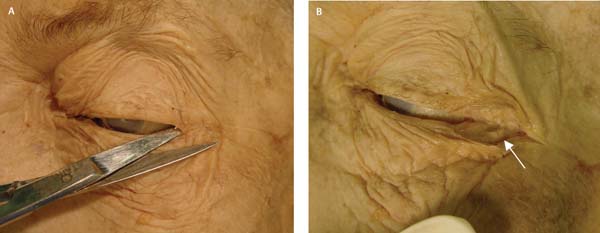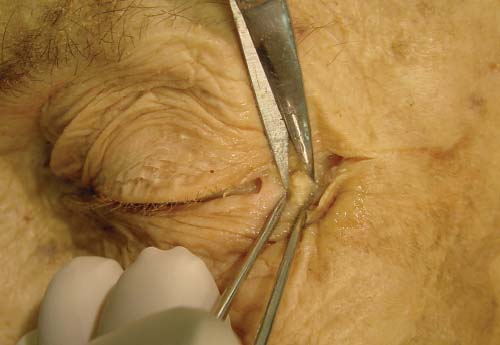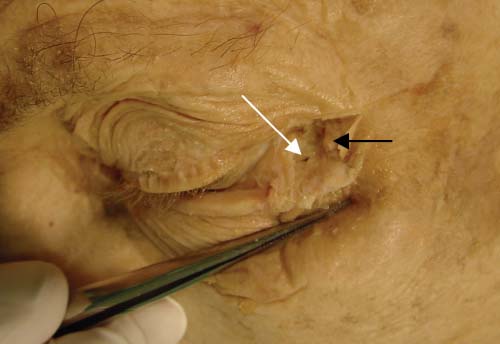14 Endoscopic orbital decompression plays an important role in the management of patients with Graves orbitopathy, in patients with acute orbital hemorrhage with proptosis, and for the drainage of orbital subperiosteal abscesses. Exophthalmos in Graves disease is thought to result from the deposition of immune complexes in the extraocular muscles and fat, which in turn leads to edema and fibrosis.1 The resultant increase in intraorbital pressure pushes the globe forward causing proptosis. If this proptosis becomes severe enough, the eyelids cannot close properly and chemosis with or without exposure keratitis of the cornea may occur. In addition, the crowding of the orbital apex by the significantly enlarged extraocular muscles places pressure on the optic nerve. In a small minority of patients stretching of the optic nerve by increasing proptosis may play a role in the development of optic neuropathy and visual loss. Visual loss is uncommon in Graves disease occurring in only 2 to 7% of patients.2,3 If medical treatment (high-dose steroids with or without low dose radiotherapy) fails, surgical decompression of the eye is indicated.4 Although this has in the past been performed via external procedures, excellent reduction of proptosis is now possible with endoscopic techniques.5,6 Figure 14.1 shows the extraocular muscle enlargement commonly seen in patients with Graves disease and visual loss. Preoperative diplopia is seen in up to 30% of patients with Graves disease. If Fig. 14.1 is reviewed it can be seen that the extensive muscle enlargement limits globe movement in the extremes of gaze which in turn will cause diplopia. After decompression significant medial and inferior prolapse of orbital tissue occurs and diplopia can be seen in up to 30% of patients who did not have preoperative diplopia. Decompression of the lateral wall is thought to balance this intraorbital tissue displacement with resultant less likelihood of post operative diploplia.7 Although orbital decompression results in significant reduction in proptosis, the patient’s eyes may still have a staring appearance due to fibrosis and shortening of the levator palpebrae muscle. This results in increased sclera show and, although there may have been significant reduction of proptosis, the cosmetic appearance would still not be ideal. A release of the levator muscles can be performed which can reduce or eliminate the scleral show. Intraorbital hemorrhage is fortunately a rare occurrence and usually occurs during endoscopic sinus surgery (ESS) as a result of injury to the anterior ethmoidal artery. The damaged artery retracts into the orbit and continues to bleed within the orbital contents with increasing intraorbital pressure. This pressure results in progressive proptosis with stretching or compression of the optic nerve. This combined with impairment of arterial blood flow to the retina from increasing intraorbital pressure can result in progressive visual loss. Color vision is reduced before visual acuity is lost. If impending visual loss is suspected, the patient should be tested for loss of red color discrimination and tested for a relative afferent pupil defect. Color vision is tested by showing the patient a picture with red in it and asking them to name the colors in the picture. Once visual acuity is lost the time before irreversible blindness occurs is variable but can be as short as 40 minutes if blood flow to the retina is lost. It is therefore important that, if intraorbital hemorrhage occurs, the surgeon immediately takes appropriate steps to reduce intraorbital pressure and restore blood flow to the retina and optic nerve. Other than progressive proptosis, subconjunctival and periorbital hemorrhage may also be visible. If the proptosed globe is palpated, it is hard and resists direct pressure. If the optic fundus can be visualized, the retinal arterial circulation may be seen to be intermittent or pulsatile. Fig. 14.1 Extraocular muscle enlargement marked with white arrow in coronal soft tissue CT scan (A) and axial CT scan (B). Note the orbital apex crowding. If an intraorbital hemorrhage is recognized intraoperatively and the patient is still on the operating table, an orbital decompression should be performed as described in later text. If the patient is in recovery area or on the ward, and significant proptosis and visual loss is noticed then, the following steps should be taken: These are important steps with which to buy time allowing the patient to be taken back to theater for reexploration and orbital decompression. Local anesthetic (lidocaine 2% with 1:80 000 adrenaline) is placed in the lateral canthal region. A sharp scissors is used to make a horizontal incision through skin and soft tissue at the lateral junction of the eyelids onto the bone of the orbital rim (Fig. 14.2). The eyelid is drawn outward with forceps exposing the tendon attaching the inferior tarsal plate to the bone and the scissors are turned vertically and this tendon cut (Fig. 14.3). Orbital fat should be seen as this tendon is cut and the eyelid should be able to be laid on the cheek without tension (Fig. 14.4). This reduces the intraorbital pressure and should allow reperfusion of the optic nerve and retina. However, it may be insufficient and is used only to buy time and allow the patient to return to theater for a formal decompression of the orbit. Fig. 14.2 (A) A horizontal cut is demonstrated on a cadaver. The horizontal cut is made onto the orbital rim through the lateral canthus. (B) Pulling the eyelid down reveals the lateral canthal tendon (white arrow). Fig. 14.3 The lateral canthal tendon is held between the forceps with the scissors held vertically to cut the tendon. Fig. 14.4 The eyelid is laid on the cheek. The cut lateral canthal tendon is marked with a black arrow and the orbital fat with a white arrow. No stitches are placed in this wound and a dressing is placed over the wound. The wound and the lateral canthal tendon can be sutured after 24 to 48 hours. The lateral canthal tendon is sutured to the orbital periosteum. As the incision is in the crease formed by the eyelids, scarring is uncommon.
Endoscopic Orbital Decompression
for Exophthalmos, Acute Orbital
Hemorrhage, and Orbital
Subperiosteal Abscess
 Graves Disease
Graves Disease
 Intraorbital Hemorrhage
Intraorbital Hemorrhage
 Sit the patient up in bed
Sit the patient up in bed
 Remove any nasal packing
Remove any nasal packing
 Infiltrate the lateral canthus with local anesthetic and perform a lateral canthotomy and cantholysis
Infiltrate the lateral canthus with local anesthetic and perform a lateral canthotomy and cantholysis
Surgical Technique of Lateral Canthotomy and Cantholysis
Stay updated, free articles. Join our Telegram channel

Full access? Get Clinical Tree







